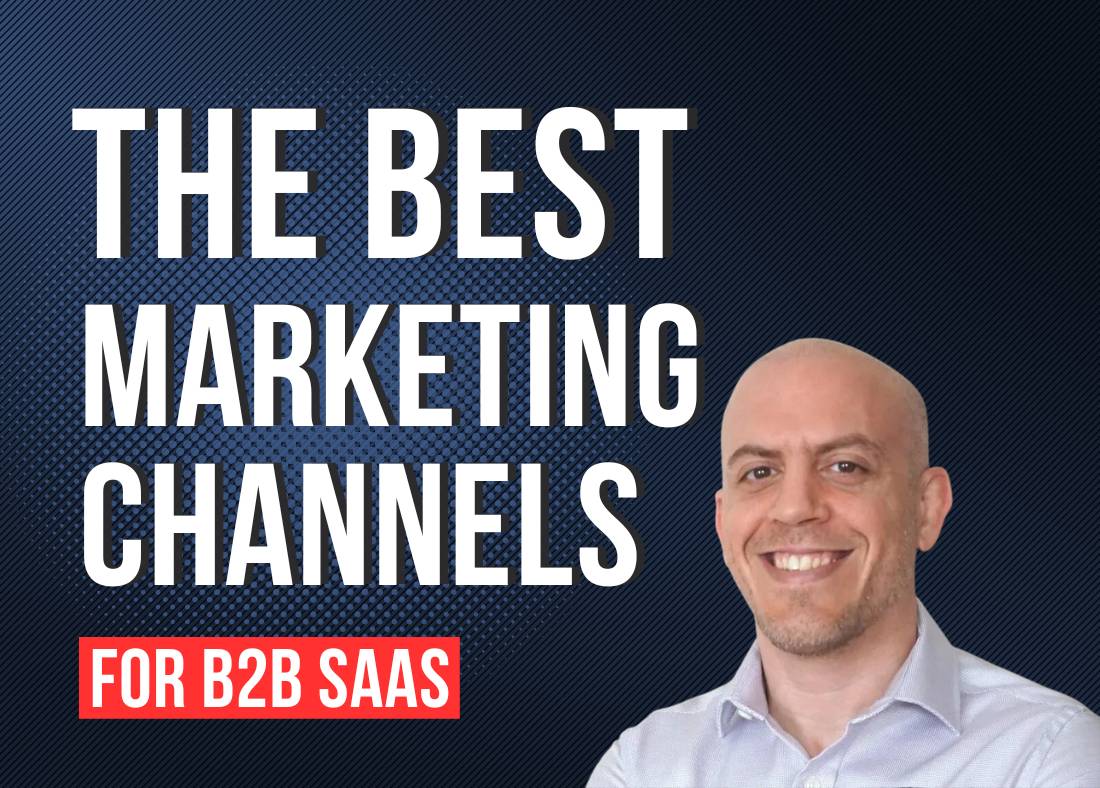When I started Gymdesk in 2016 as a solo founder, I had high confidence I could ship a working product, but much less confidence in my ability to generate demand and acquire customers – i.e, marketing.
Over the past 8+ years I had to learn how to generate leads and convert them to paying customers through many experiments, failures, persistence and learning from others. I did this without raising venture capital, and having the budget to “buy” customers through expensive paid ads with a long payback period.
In my experience, the best marketing channels for B2B SaaS include:
- Organic Search Traffic / SEO
- Software Comparison Websites
- Partnerships & Integrations
- Resellers
- Referral programs
- Inbound product mentions
- Social media
- Outreach via linkedIn and Email
In this article I’ll explain how each one of those works. But before that, let’s talk about something else –
How do you grow revenue with B2B SaaS?
There are 3 levers you can use to increase revenue with B2B SaaS –
- Generate more leads
- Improve conversion rates from leads to paying customers
- Adjust your pricing plans
From there it’s just basic math: (number of leads x conversion rate x average monthly plan) = new monthly recurring revenue. This, of course, does not account for churn – the lower the churn the easier it is to grow recurring revenue.
In this article I’ll be focusing on the first lever, lead generation.
What Are the Best Marketing Channels For B2B SaaS?
There are 3 main factors that determine which channels are best suited for a B2B SaaS product – ACV (annual contract value), pabyack period and the amount of available capital.
ACV (annual contract value) – an ACV below $3000 would typically make a sales-first approach too expensive (with exceptions). Below this range, you should focus on building a low-touch funnel, vs. high-touch funnel for higher ACV products, where the higher cost requires handling more objections.
Payback period – the time it would take get back the initial cost of acquiring a lead. Certain channels become too expensive depending on the lead acquisition cost and ACV, as well as your run-rate.
Amount of capital you have – The channels available to bootstrapped companies vs. VC funded companies are different, as the latter can afford to lose money while driving growth, while the former has to prioritize short-term profitability. Being in a vertical that requires capital intensive marketing channels is often a catalyst for raising venture capital – see my article on Bootstrapping vs. Venture Capital.
Our product has a low ACV (our top standard plan maxes out at $300 and goes a bit higher with add-ons). We’ve also been mostly bootstrapped, so we had to discover capital efficient channels to generate leads.
Over years of slowly ramping our marketing efforts as a technical solo-founder, the list below are the channels that worked the best for us:
Organic Search Traffic
For product-led / low ACV SaaS, organic traffic is the first channel I would recommend investing into. Organic search traffic has been our most consistent and highest converting channel over the years.
This is a channel that took us quite a while to figure out, especially in the early days when I was doing everything myself and didn’t have the capacity or know-how to properly invest in it. But now it accounts for over 60% of our leads and new revenue.
Organic search traffic leads convert at some of the highest rates compared to other channels, since leads are already looking for something related to your product – the more relevant keywords you can capture, the better.
I’m currently seeing %35+ conversion rates from leads -> paying customers coming through organic search, but this can vary based on your current product-market-fit.
I’ll be writing a detailed breakdown of how we created a consistent process for generating content and organic traffic that translates into leads and revenue, in a future article.
Software Comparison Websites
Software comparison websites list companies in a specific category (for example, accounting software) and allow visitors to review it. Those websites are a useful resource for people currently shopping for specific software solutions. The biggest ones include Capterra, Software Advice, GetApp and G2.
Through some clever positioning and authority building, some of those websites have been able to capture the top positions in search results for many high conversion keywords. As a result, this is somewhat an extension of #1 above, as it would be hard to rank above those sites for many competitive search keywords.
Though on the surface it seems that it’s free to create a profile on comparison website, all of the top websites in this category have a pay-to-play model for competitive categories. In order to rank anywhere decent, you have to pay either a subscription fee or via a pay-per-click model.
To see if this channel could work for you, just Google “best {your vertical} software” and see if any of those websites show up in the top results. If it does, even a small budget can you send a consistent trickle of leads. This is the channel that drove the most leads for us in the beginning when we had no other channels developed. With a $200 / month budget, I was getting a solid 8-10 leads a month, which was instrumental in building our early customer base.
If you’re interested in learning more about this channel, I talked about it in length with Rob Walling on MicroConf Remote 5.0.
Partnerships / Integrations
Partnering with other companies that provide different services but have a similar target audience, is excellent way to send each other highly qualified leads. For software products, integration partners can often be excellent partners for this purpose.
Reach out to potential marketers for co-marketing opportunities. For example:
- Create a mutual case-study highlighting how the integration works for both products.
- Create a landing page highlighting the case study on each companies’ web properties.
- Send an Email blast highlight the case study to both customer bases.
- Some larger integration partners will have an “integration marketplace” where they list all of their integration partners. Getting on that marketplace is an excellent way to generate a constant stream of highly qualified leads.
- Provide guest articles on each other’s blogs.
Most larger companies will have a dedicated partner management department – you should reach out to get connected to the person whose goal is to make sure your integration is successful, and they should be able to help you capitalize on those co-marketing opportunities.
Resellers
Resellers repackage your product and resell it to their customers with some sort of value-add. A common type of reseller for B2B SaaS is a service company providing services which utilize your product. They then sell your product as part of a larger service offering to their end customers.
For example, as we provide gym management software, some of our resellers are either payment providers or gym management companies who then sell a complete service offering that includes onboarding and setting up our product as part of their holistic solution.
Resellers can be an excellent source of paying customers as you get to offload the marketing efforts and provide your product as part of service offerings you don’t provide internally. When the incentives align for both companies, this can be highly effective – for us, around 15% of new MRR growth comes from resellers.
Affiliate / Referral Program
Existing customers that are happy with your product are also an excellent source of new customers. A referral from someone you trust is a much stronger signal than reading an online review from a stranger.
A referral program is a good way to incentivize referrals – by rewarding successful referrals with an upfront commission or account credit. Figuring out the right commission structure can take some trial-and-error, so don’t be afraid to tinker and adjust with it.
Creating awareness for the referral program is also important – we created a section in the user account’s settings that reports on referral and commissions, and we also include a mention to the referral program in the footer of our automated system emails.
Inbound Product Mentions
Referral traffic from other websites is another channel that can tap in to audiences unfamiliar with your brand. “Link building” is a common strategy for SEO, as inbound links help establish authority with search engines, however don’t discount the value of the traffic itself – if the content linking to you is relevant enough, it should result in incremental increase of leads over time.
Ideally, you will earn those links organically, however when you are small you would likely need to consistently reach out to other websites for collaboration. There are many opportunities for that if you look for it:
- Guest blogging about a topic relevant for your audience that links back to your website
- Asking for inclusion in listicles, comparison articles and resource articles in your niche
- Signing up on various business directories and online business profiles
- Doing interviews / podcast with industry influencers
There’s likely industry specific websites that would fall into this category that would be worth seeking out. For example, we became an industry partner for USA Gymnastics, as we are a service provider for gymnastics gyms, earning a link from their website that would refer gyms looking for similar solutions there.
Social Media
Social media might be less or more relevant depending on the vertical you’re in. If your target audience is on social media – Facebook / Instagram / TikTok / Reddit (and even Youtube), establishing a consistent, helpful presence there can go a long way towards strengthening your brand and potentially driving leads.
Your onsite content efforts can often feed into your social media content – you can repurpose successful blog posts and articles into bite-sized quotes and extracts that can then be posted on social media. Video content such as podcasts and founder interviews can be cut up into short videos with little additional effort.
Though it’s not a fit for every vertical, it’s worth taking a serious look at whether social media can work for you as a lead acquisition and brand building channel.
Outreach via linkedIn & Email
In some industries, the best way to get in front of a potential customer is to send them a timely email or linkedIn message introducing your solution and trying to get them on a demo call.
For us with Gymdesk, I did not focus on it until recently, when we started targeted bigger franchises and partnerships.
Cold outreach needs to be approached carefully – it’s too easy to come across as spammy or self centered. You need to get to the point quickly, as to not waste people’s time and attention span, as well as make it about what you can do for them instead of what they can do for you.
For some SaaS products, cold outreach in the early stages is the best way to acquire your first customers. And if you can build a scalable process from it, you can then build it into an effective marketing channel.
Building a strategy that works for you
I listed the marketing channels in the order of value to our marketing efforts. The effectiveness of each channel could be completely different for your company, and some might not work at all (while some might surprise you).
We are still exploring and discovering new channels constantly, and refining our existing funnels based on lessons learned from previous efforts. In my next article, I’ll do a deep dive into our content strategy and how it’s the main driver of revenue growth for our business.
If it goes well for you, you might get one day to have Rob Walling say this about you –
(From Startups for the rest of us: Episode 728 – Bootstrapping Gymdesk to a More Than $32.5M Exit)





